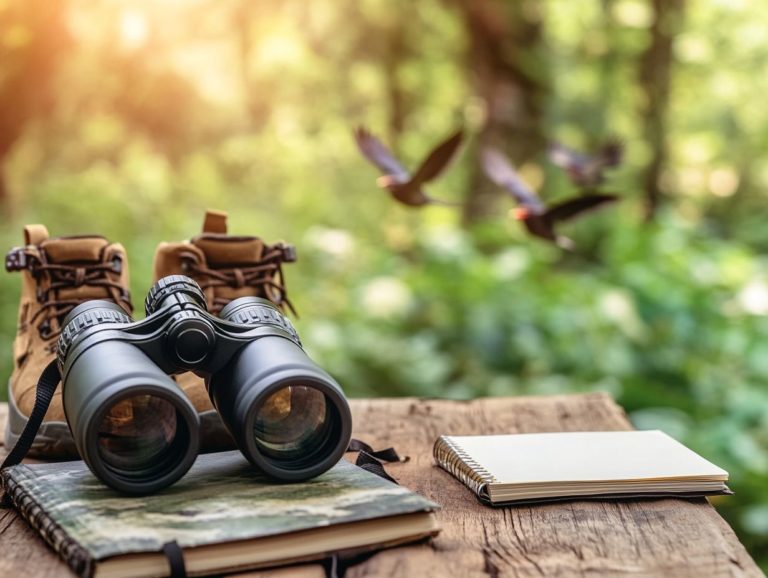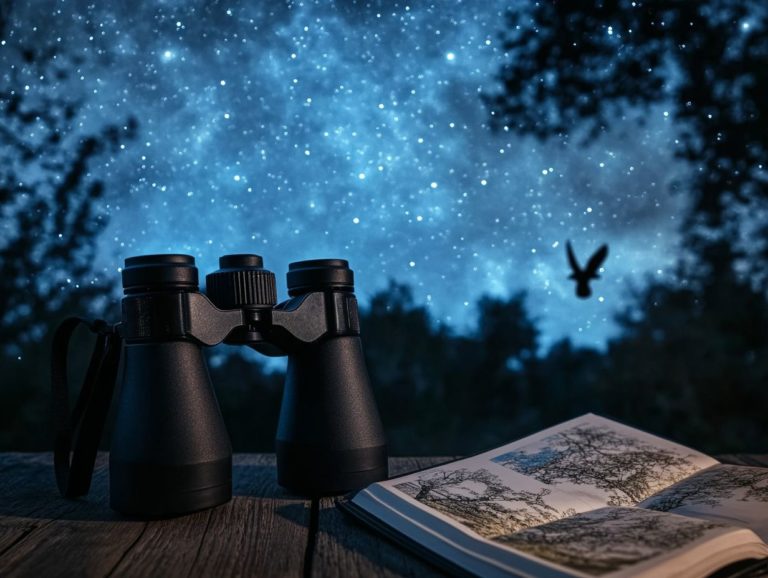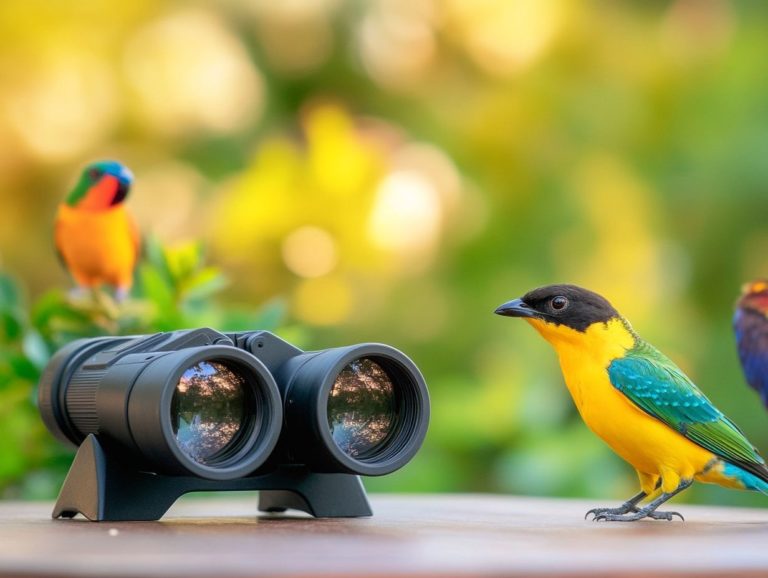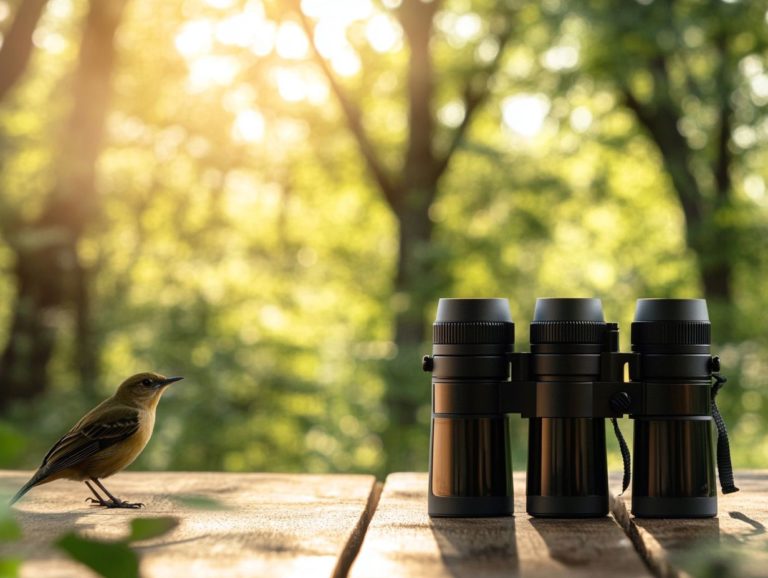A Beginner’s Guide to Bird Watching Binoculars
Bird watching is a delightful hobby. It opens up a world of nature right outside your window or on your next adventure.
To enhance your experience, investing in quality binoculars is essential. This guide explores various types of bird watching binoculars, from Porro to Roof Prism styles.
We ll look at crucial features to consider when selecting the perfect pair. This guide also covers effective techniques for using binoculars.
You’ll find maintenance tips to keep them in top shape. Whether you re starting out or ready to elevate your birding game, this guide will support your journey.
Contents
- Key Takeaways:
- Types of Bird Watching Binoculars
- Features to Consider when Choosing Binoculars
- Using Binoculars for Bird Watching
- Caring for Bird Watching Binoculars
- Recommended Bird Watching Binoculars for Beginners
- Frequently Asked Questions
- What are bird watching binoculars?
- Why do I need bird watching binoculars?
- What features should I look for in bird watching binoculars?
- Can I use any binoculars for bird watching?
- How do I choose the right magnification for bird watching binoculars?
- Do I need to spend a lot of money on bird watching binoculars?
Key Takeaways:
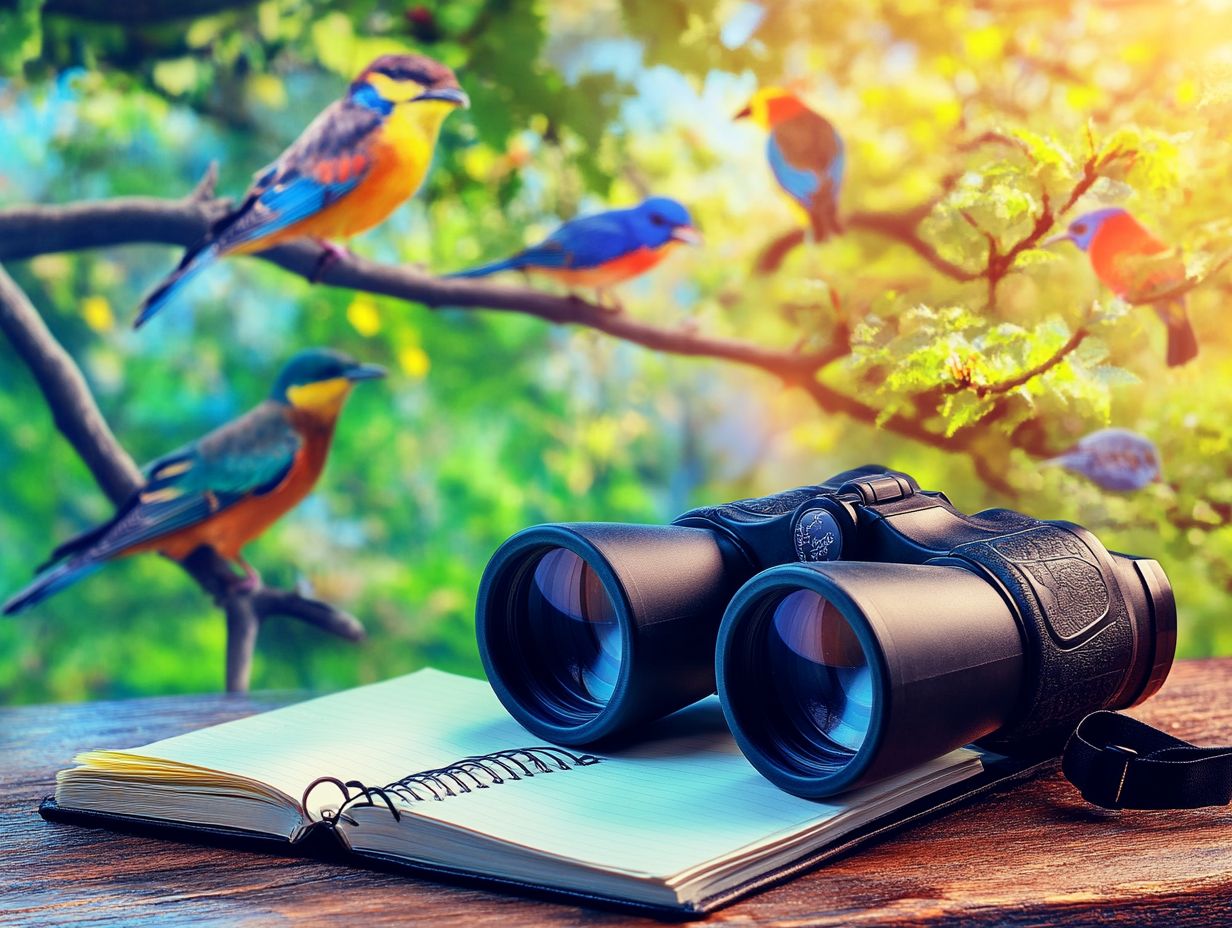
Choose the right type of binoculars based on your needs. Consider important features like magnification, lens size, and coatings.
Practice proper techniques and ensure you maintain your binoculars for optimal performance. Follow these tips to enhance your bird watching experience.
What are Bird Watching Binoculars?
Bird watching binoculars are specialized optical instruments made for enthusiasts eager to observe birds. They elevate your viewing experience, allowing you to see birds clearly from a distance. To enhance your experience even further, check out the best gear for beginners.
Unlike standard binoculars, bird watching binoculars are designed specifically for observing birds. They offer higher magnification and wider fields of view, ensuring vibrant colors even in low light. For those just starting out, checking out the best field guides for beginners in bird watching can enhance your experience.
Many models are lightweight and compact, making them easy to carry on hikes. With water-resistant and fog-proof designs, these binoculars provide the durability needed for tracking birds in challenging habitats.
Types of Bird Watching Binoculars
You ll find a variety of birdwatching binoculars suited for avid birders. Both Porro Prism and Roof Prism models have unique advantages that can enhance your birding experience.
Porro Prism vs Roof Prism Binoculars
When choosing between Porro Prism and Roof Prism binoculars, each type has distinct advantages. These binoculars are essential tools for any birdwatcher.
Porro Prism binoculars have a traditional design, offering a wider field of view and superior depth perception. These features are helpful when spotting fast-moving birds.
Conversely, Roof Prism binoculars are more compact and lightweight, making them easy to carry. If portability is your priority, you might lean towards Roof Prism models.
If you value depth and vibrant color, consider the Porro version. Understanding these differences can elevate your birding adventures.
Features to Consider when Choosing Binoculars
Selecting the right binoculars for birdwatching requires careful consideration of several key features: magnification, objective diameter, field of view, close focus, and eye relief. For more detailed guidance, check out what to look for when buying birding binoculars. Each element is vital for enhancing your birding experience.
These features help ensure you can accurately identify birds in various environments. Keep them in mind as you make your purchasing decisions.
Magnification and Objective Lens Size
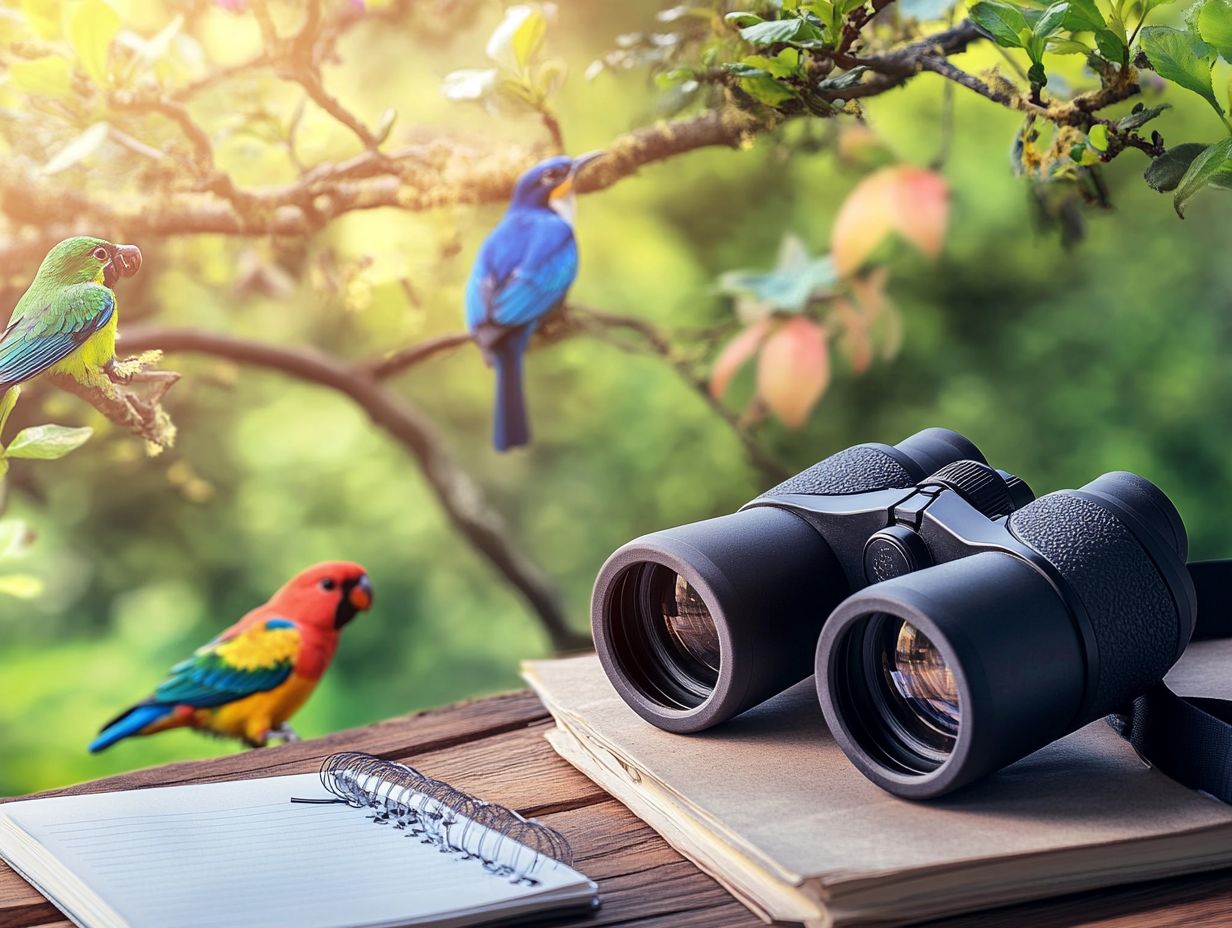
Magnification and objective lens size are key factors to consider when selecting binoculars. They directly influence how clearly and how far you can observe while birdwatching.
Using the right binoculars transforms your birdwatching experience. Higher magnification shows distant birds in detail while a larger lens gathers more light, ensuring you see clearly even in low light. For newcomers, consulting field guides for birdwatching can enhance your knowledge and enjoyment.
This perfect combination allows you to appreciate every subtle feather pattern and vibrant color. Investing in high-quality birding optics enriches your visual experience and helps you distinguish between similar species, providing a deeper understanding of avian behavior in their natural habitats.
Field of View and Close Focus
The field of view and close focus capabilities play a crucial role in observing birds. They allow you to track movements effortlessly and appreciate finer details, even from close range.
These elements enhance your birding experience and influence the types of optics you choose. A wide field of view enables you to scan surroundings quickly, capturing fleeting moments as birds dart through dense foliage. This feature is especially beneficial for high-powered viewing.
Close focus capabilities offer a chance to examine intricate features, such as plumage variations and behaviors up close. This deepens your understanding and appreciation of avian life.
Invest in optics that enhance these features. You’ll connect more deeply with nature and discover the wonders around you.
Prism Type and Coatings
The type of prism and the coatings on your binoculars are crucial factors that influence image quality, brightness, and overall performance. For discerning birders like you, these elements are essential for achieving the best viewing experience.
Different prism systems, such as BaK-4 and BK-7, play vital roles in light management within your binoculars. BaK-4 prisms are preferred because they transmit more light and reduce distortion, especially important during early morning or late afternoon birdwatching.
The coatings on the lenses enhance light transmission and minimize glare. This allows you to observe the intricate details of your feathered subjects without distraction. By prioritizing optical quality, you elevate your birdwatching experience and set the stage for fulfilling adventures in the field.
Using Binoculars for Bird Watching
To use binoculars effectively for bird watching, blend proper technique with careful adjustments. This approach enhances your observation experience, enabling you to identify birds with both ease and precision in their natural habitats.
Mastering these skills makes you part of the avian world. Tools like 7×42 binoculars or 10x40s will help you spot birds effortlessly.
Proper Technique and Adjustments
Proper technique and adjustments are essential for you as a bird watcher. They ensure the best sighting experience, elevating both clarity and comfort when viewing through binoculars.
To maximize effectiveness, adjust the eyecups based on whether you wear glasses. This allows for an optimal field of view and ensures comfort during prolonged bird watching. Using the right grip is crucial; hold the binoculars steady with both hands while tucking your elbows against your body for improved stability. This technique minimizes image shake, making it easier to spot elusive birds.
If you’re planning an extended session in the field, consider employing a harness or tripod to maintain a steady view while tracking your feathered friends in varying light conditions. Such adjustments enhance your observational capabilities and contribute to a more enjoyable bird-watching experience.
Caring for Bird Watching Binoculars
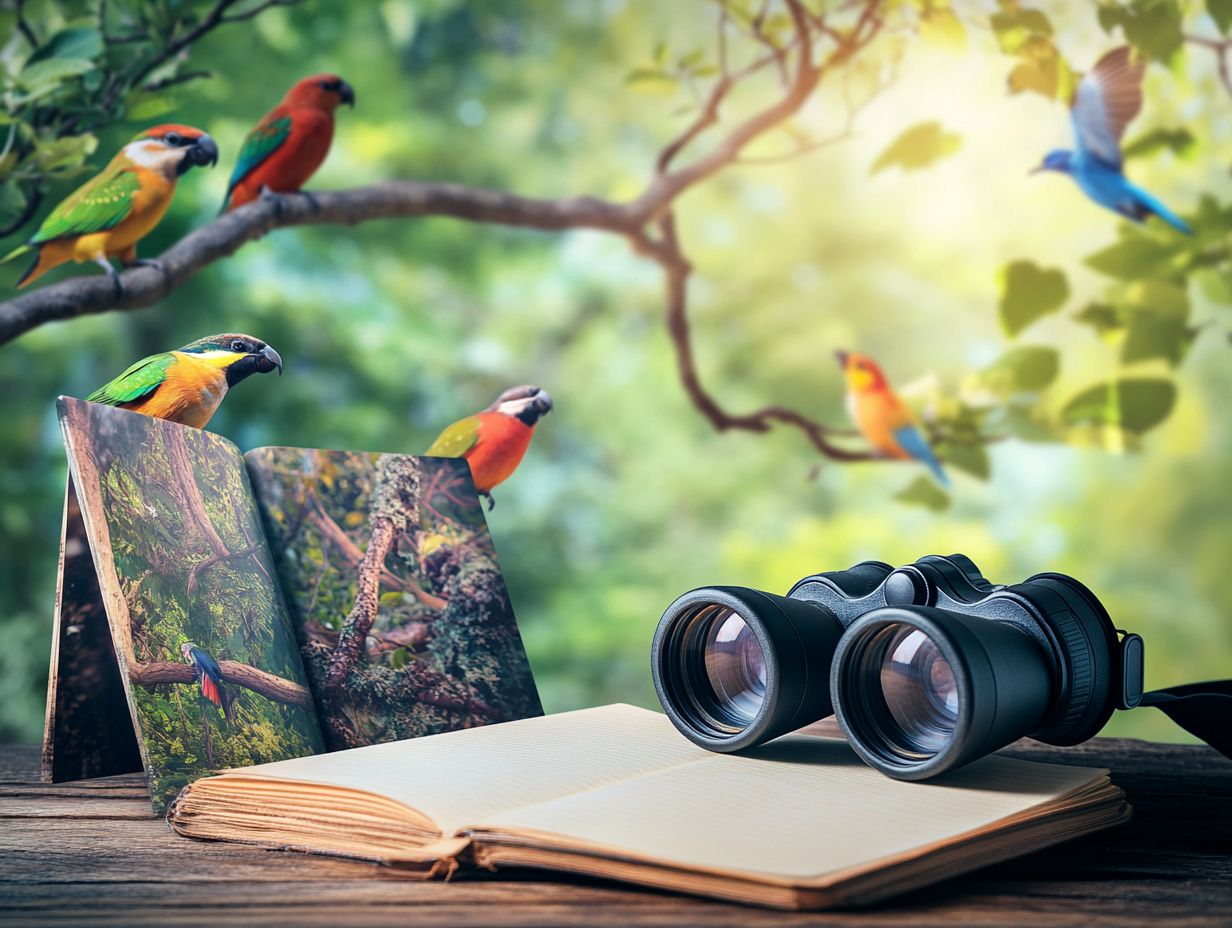
Caring for your bird watching binoculars is crucial to preserving how well they work and their performance. By doing so, you ensure that they provide you with the optimal viewing experiences you seek while observing wildlife in their natural habitats.
Cleaning and Maintenance Tips
Want your binoculars to last? Here’s how to care for them!
Cleaning and maintaining your binoculars with care can significantly enhance their lifespan and performance. This allows you to enjoy bird watching without any interruptions, whether you’re in a Milwaukee park or New York City.
Regularly inspect the lenses for dirt and smudges. A soft brush or microfiber cloth is your best friend for removing debris without causing scratches. This ensures your binoculars from brands like Leica, Zeiss, and Swarovski last for years. For more stubborn spots, just a few drops of lens cleaning solution on the cloth can work wonders.
When you’re not using your binoculars, store them in a padded case to guard against dust and moisture. This helps minimize the risk of damage. Follow these simple tips to unlock a world of bird watching excitement!
Recommended Bird Watching Binoculars for Beginners
As a beginner venturing into the world of bird watching, selecting the right binoculars might seem overwhelming at first. However, you’ll find several highly recommended models and essential bird watching gear for beginners that stand out for their quality, functionality, and easy-to-use design.
These options can greatly enhance your birding experience, ensuring it is both enjoyable and rewarding right from the start.
Top Picks and Reviews
Here are some top picks for binoculars for beginners in birding. Each offers unique features and benefits designed to enhance your birding experience.
These models seamlessly combine easy-to-use designs with essential optical performance. This ensures that even novice bird watchers like you can fully appreciate the vibrant details of avian life. By narrowing down your choices based on factors like magnification (the degree to which the binoculars can enlarge an image), field of view, and brightness, you’ll be able to select a pair that perfectly aligns with your individual needs, such as the best binoculars for backyard bird watching.
Whether you re in search of portability for those hiking adventures or stability for observing birds at dusk, there’s definitely something that suits your requirements. Understanding these specifications gives you the power to make informed decisions, ultimately leading to more rewarding outings in the great outdoors.
Let’s explore the various models that stand out as the best options for observing birds in their natural habitats.
Frequently Asked Questions
What are bird watching binoculars?
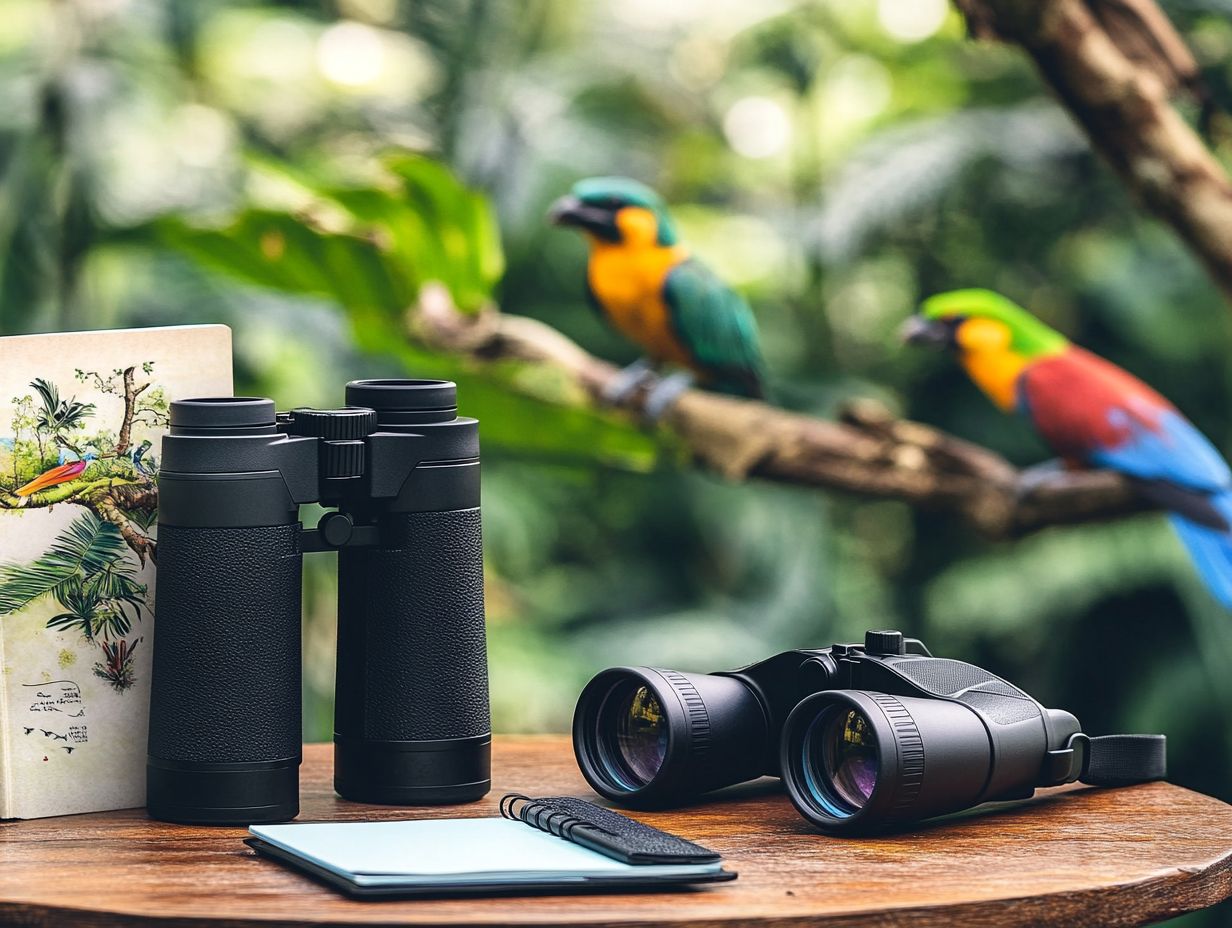
Bird watching binoculars are specialized optical instruments that allow users to view birds in their natural habitats from a distance. For those interested in making the best choice, a guide to choosing binoculars for wildlife viewing highlights specific features designed to enhance the viewing experience, such as high magnification, wide field of view, and close focus capabilities.
Why do I need bird watching binoculars?
Bird watching binoculars provide a better and more detailed view of birds compared to the naked eye. They also allow you to observe birds without disturbing their natural behavior or habitat, making it a more ethical way to enjoy bird watching.
What features should I look for in bird watching binoculars?
Some important features to consider when choosing bird watching binoculars include magnification power, lens diameter, field of view, close focus, and lens coating. These factors determine the quality and clarity of the image you will see through the binoculars.
Can I use any binoculars for bird watching?
While any binoculars can technically be used for bird watching, it is recommended to use binoculars designed for bird watching. These binoculars have features that are optimized for viewing birds, such as higher magnification and better close focus capabilities.
Ready to start bird watching? Grab your binoculars today!
How do I choose the right magnification for bird watching binoculars?
Choosing the right magnification for bird watching binoculars is essential!
If you’re watching general birds, go for 8x to 10x magnification. For spotting distant or smaller birds, 10x to 12x is the way to go!
Do I need to spend a lot of money on bird watching binoculars?
Not necessarily! While high-end bird watching binoculars can be expensive, you can find budget-friendly options too.
These options still offer decent quality and features. It’s important to research and read reviews to find the best binoculars that fit your budget and needs.


